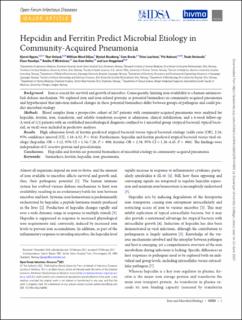Hepcidin and Ferritin Predict Microbial Etiology in Community-Acquired Pneumonia
| dc.contributor.author | Oppen, Kjersti | |
| dc.contributor.author | Ueland, Thor | |
| dc.contributor.author | Siljan, William Ward | |
| dc.contributor.author | Skadberg, Øyvind | |
| dc.contributor.author | Brede, Cato | |
| dc.contributor.author | Lauritzen, Trine | |
| dc.contributor.author | Aukrust, Pål | |
| dc.contributor.author | Steinsvik, Trude | |
| dc.contributor.author | Husebye, Einar | |
| dc.contributor.author | Michelsen, Annika | |
| dc.contributor.author | Holter, Jan Cato | |
| dc.contributor.author | Heggelund, Lars | |
| dc.date.accessioned | 2021-08-13T06:50:03Z | |
| dc.date.available | 2021-08-13T06:50:03Z | |
| dc.date.created | 2021-06-21T15:08:53Z | |
| dc.date.issued | 2021 | |
| dc.identifier.issn | 2328-8957 | |
| dc.identifier.uri | https://hdl.handle.net/11250/2767677 | |
| dc.description.abstract | Background Iron is crucial for survival and growth of microbes. Consequently, limiting iron availability is a human antimicrobial defense mechanism. We explored iron and iron-related proteins as potential biomarkers in community-acquired pneumonia and hypothesized that infection-induced changes in these potential biomarkers differ between groups of pathogens and could predict microbial etiology. Methods Blood samples from a prospective cohort of 267 patients with community-acquired pneumonia were analyzed for hepcidin, ferritin, iron, transferrin, and soluble transferrin receptor at admission, clinical stabilization, and a 6-week follow-up. A total of 111 patients with an established microbiological diagnosis confined to 1 microbial group (atypical bacterial, typical bacterial, or viral) were included in predictive analyses. Results High admission levels of ferritin predicted atypical bacterial versus typical bacterial etiology (odds ratio [OR], 2.26; 95% confidence interval [CI], 1.18–4.32; P = .014). Furthermore, hepcidin and ferritin predicted atypical bacterial versus viral etiology (hepcidin: OR = 3.12, 95% CI = 1.34–7.28, P = .008; ferritin: OR = 2.38, 95% CI = 1.28–4.45, P = .006). The findings were independent of C-reactive protein and procalcitonin. Conclusions Hepcidin and ferritin are potential biomarkers of microbial etiology in community-acquired pneumonia. | en_US |
| dc.language.iso | eng | en_US |
| dc.publisher | Oxford University Press | en_US |
| dc.rights | Attribution-NonCommercial-NoDerivatives 4.0 Internasjonal | * |
| dc.rights.uri | http://creativecommons.org/licenses/by-nc-nd/4.0/deed.no | * |
| dc.title | Hepcidin and Ferritin Predict Microbial Etiology in Community-Acquired Pneumonia | en_US |
| dc.type | Journal article | en_US |
| dc.type | Peer reviewed | en_US |
| dc.description.version | publishedVersion | en_US |
| dc.rights.holder | Copyright The Author(s) 2021. | en_US |
| dc.source.articlenumber | ofab082 | en_US |
| cristin.ispublished | true | |
| cristin.fulltext | original | |
| cristin.qualitycode | 1 | |
| dc.identifier.doi | 10.1093/ofid/ofab082 | |
| dc.identifier.cristin | 1917382 | |
| dc.source.journal | Open Forum Infectious Diseases | en_US |
| dc.identifier.citation | Open Forum Infectious Diseases. 2021, 8 (4), ofab082. | en_US |
| dc.source.volume | 8 | en_US |
| dc.source.issue | 4 | en_US |
Tilhørende fil(er)
Denne innførselen finnes i følgende samling(er)
-
Department of Clinical Science [2312]
-
Registrations from Cristin [9715]

